Last week we shared with you a number of dark clouds casting a shadow on the markets. We emphasized that it was a point where the markets (both stock and bond) either broke down or broke out.
We got to witness both.
The stock market rallied out of a long sideway consolidation pattern and made a new year-to-date high as well as a positive 52-week period. The S&P 500 was up 1.71%, and the Nasdaq 100 was up 3.53% for the week. It was a good positive week, given the potential dark clouds.
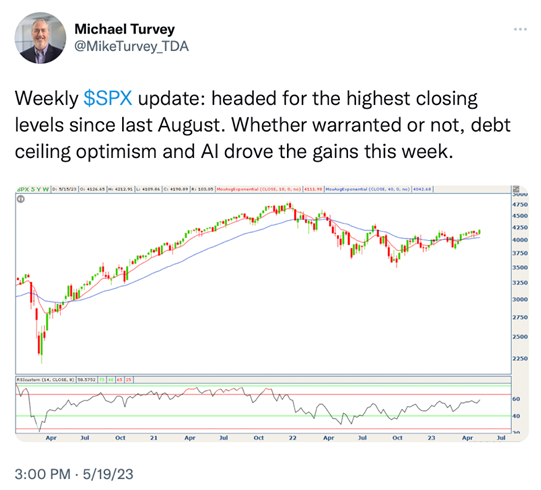
Additionally, the advance-decline lines improved, showing strength in markets that just a week earlier had many analysts and economists voicing ongoing concern. As you’ll see in the charts of the Nasdaq 100 and S&P 500 below with their advance/decline lines (in red), they both seem to be doing fine. See charts below:

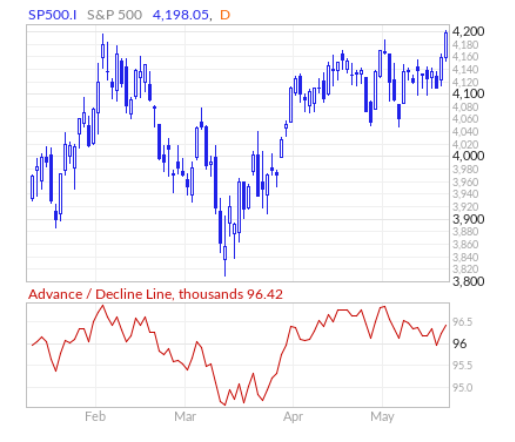
After hitting their lows in October, the markets have continued to rally and have not looked back. One of our favorite market technicians, Ryan Detrick, from the Carson Group, provided an excellent summary of what stocks are likely to do after they have gone 7 months without hitting a new low. See chart below:

To summarize, this chart lays out a positive message for stocks so far in 2023 as we near the halfway point.

After several positive economic reports of better-than-expected retail sales coupled with good earnings reports from Target (NYSE:TGT) and Walmart (NYSE:WMT), hopes for a near-term Fed pause or pivot momentarily declined.
Additionally, the new Dallas Fed President, Lorie Logan, suggested that the Fed needed to continue raising rates to slow inflation. This echoes what we stated in this column last week.
The bond market, with expectations of a “pause” and possible “pivot,” did not fare nearly as well as the stock market. Interest rates rose and bonds sold off. The odds on future interest rate hikes went up during the week.
Long-term bond prices broke down, and our favorite instrument iShares 20+ Year Treasury Bond ETF (NASDAQ:TLT) (20-year Treasury Bond ETF), headed towards its previous 6-month lows. See chart below:
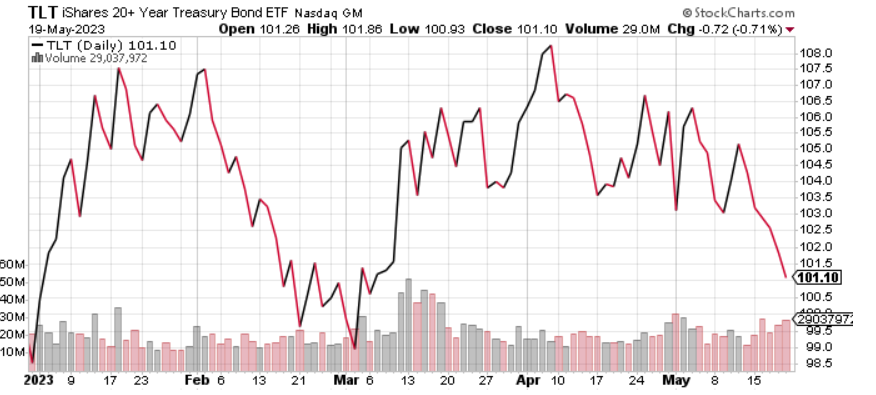
While we have suffered through a bear market in stocks since the beginning of 2022, for the past 3 years, the stock market has been the place to be invested. A graph that follows shows the relative performance of the SPY to be consistently better than the TLT’s:
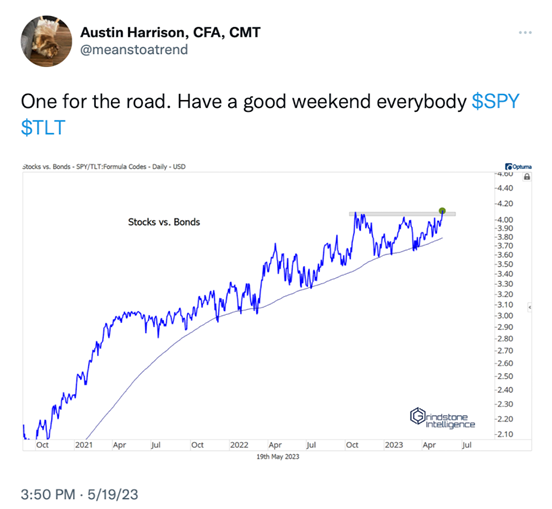
Additionally, the US Dollar Index Futures rallied and put pressure on commodities and precious metals. The new strength, however, did not negatively affect the stock market as it did during most of 2022. See graph below.
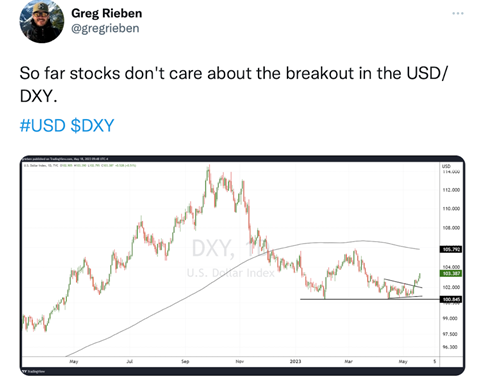
There are still areas of concern.
Last week we went over the 5 dark clouds that loomed large over the markets. We are not changing our tune, for the moment.
While the stock market (not necessarily the bond market) continues in its uptrend, the dark clouds of the lingering debt ceiling crisis, weakness in the regional banking sector, a slowdown in the economy (recession fears), and likely earnings declines, persist. The one dark cloud -- the market’s negative behavior, for now, may have been taken off the table. However, let’s briefly explore a few of the other near-term issues.
- The pending debt ceiling crisis. Part of the reason the stock market was having a positive week rested firmly with expectations coming out of Washington that a deal to settle the debt ceiling was well in hand. Until Friday. Then, it was reported that negotiations broke down, and both sides walked away from the table. The stock market sold off.
It appears that both sides of the table would like to avert a crisis. Time is running out. However, in Washington D.C. they seem to settle things at the last minute.
Treasury Secretary Janet Yellen continues to sound the alarm suggesting that a default could plunge the country into a recession and send borrowing costs soaring.
If a default, even a short lived one, should occur, look for the stock market to sell off. This would predicate a likely severe slowdown in the economy which will affect future corporate earnings, and analysts will begin to readjust earnings expectations quickly.
On the converse of this, over the weekend, Point72 founder and New York Mets owner Steve Cohen came out and said he thinks “investors are too worried about a market downturn. I’m making a prognostication—we’re going up thanks to a boost from artificial intelligence.”
- Regional Banking. During Thursday’s meeting with the CEOs of large banks, Treasury Secretary Janet Yellen told executives that more bank mergers may be necessary as the industry continues to navigate through a crisis. Remember when just a few weeks ago, the Treasury Secretary and the Federal Reserve Chairman both told investors that the banking system remains sound? Look for more problems with Regional Banks as they wrestle with the duration risk of their investment portfolios. The bank investment portfolios, especially at smaller regional banks, are negatively affected by higher interest rates.
- Interest rates and the economy. As we have pointed out previously, many economists, analysts, and money managers continue to believe that we are headed into a recession. And the world has been eagerly awaiting a signal from the US Federal Reserve that its policy tightening was near an end. This past week several Fed officials (see Lorie Logan above), came out suggesting that the Fed should NOT BE DONE. Inflation, as we have pointed out on numerous occasions, remains elevated and not likely to fall below 3.5%-4.0% anytime soon (far from the Fed’s 2% objective).
Fed Chairman Powell spoke at a conference on Friday and finally gave the sign that the Fed may be ready to “pause” and let the 10 historic raises do their work. But his comments were supplanted by the pending obstacle out of the Fed’s control which is the debt crisis which could take place in 10 days. That could send the US economy into an immediate recession if the US cannot fully pay its bills.
- The stock market’s positive behavior is still perplexing to some. A number of credible analysts came out this week still questioning the recent rise in the stock market and suggested that it was nothing more than a retracement of the 2022 bear market. Schwab’s Liz Ann Sonders highlighted her concerns in two charts below. One showing the behavior of the 2011 stock market, which was plagued by zero growth projections eerily similar to those we see in 2023:
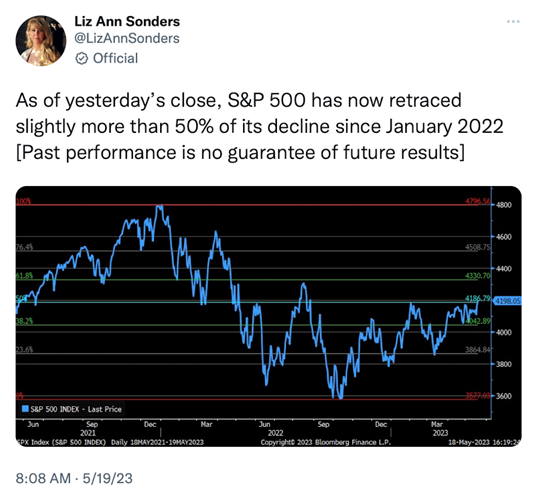
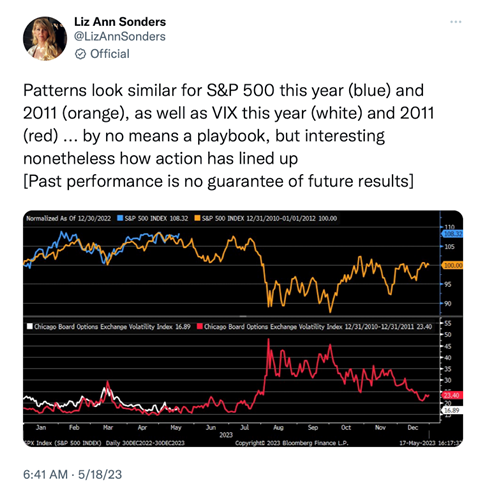

Also, the Dow Jones Industrial Average (DJIA) as well as the Russell 2000 small cap index (IWM) are not participating in this recent runup in the S&P 500 and the NASDAQ 100 (QQQ). Many analysts point out that either the DJIA and IWM “catch up” or the S&P 500 and NASDAQ 100 need to correct to get more in line. Here is a good chart indicating the historical performance spread between the DJIA and the NASDAQ 100 (QQQ). This is causing concern among some analysts.

- Our own Mish Schneider provides a different perspective than those above. “While analysts are bearish, MarketGauge risk on indicators tell a different story.”
If you have not read it already (from May 17), make sure you read it now. It is a very good rebuttal to Liz Ann Sonders above and other analysts who reside in the negative camp. You can read her article here, “Analysts are Bearish While Risk-On Explodes!” You can also frequently find analysis of the same indicators Mish refers to in her article in the Big View bullets and video section below by Keith.

The MarketGauge investment strategies. Why following our methodology can produce lasting profits. Why locking in profits is so important in today’s investment environment.
Sometimes I realize we may sound like a broken record... pontificating about our investment methodologies (using stops and targets). Also urging investors to rely upon quant-based, algorithmic, and rules based investment strategies that have demonstrated over time that they work better than most long-term discretionary trading strategies.
PLEASE ASK US TO SEND YOU THE HISTORICAL PERFORMANCE INFORMATION SO YOU CAN SEE FOR YOURSELF. You can reach me directly at donn@mgamllc.com.
This past week we took multiple profits in several of our investment strategies. We hit targets (2nd target in one) in several of our investment strategies. These are so important as they LOCK in the gains and appreciation of individual stock or ETF positions. This is how many of the world’s best traders are consistently profitable and build wealth for their clients. When they have a profit, they don’t let the market take it back.
Part of the reason that the MarketGauge investment strategies and blends do so well over time is that they incorporate disciplined risk management techniques. These include pre-determined STOPS and TARGETS. If the position is not working out (as we had expected) and begins to fall, we take either a partial position off or all of it (different among individual strategies) to reduce the overall risk.
If we hit a pre-determined target, as we did several times this past week, we LOCK IN THE PROFIT. An interesting example is that after we took the profits off the table on Thursday, all three of the individual positions trended lower on Friday. In MANY cases, we have taken targets off the table before a more prolonged decline (FSLR recently).
If you would like to see our individual strategies or our powerful ALL WEATHER Blends, which are optimally constructed using these individual strategies, please reach out to Keith@MGAMLLC.com, Rob@MarketGauge.com or myself, Donn@MGAMLLC.com.

Risk-On
- 2 of the 4 key indices (SPY and QQQ) put in new 2023 closing highs after a strong week, while the Russel (IWM) regained its 50-day moving average as support. (+)
- Volume patterns improved significantly with the exception of the Diamonds (DIA) which is still showing twice as many distribution days as accumulation days over the past 2 weeks. (+)
- Sector rotation was led by speculative sectors such as Semiconductors (SMH), Technology (XLK), and Consumer Discretionary (XLY), while Risk-Off sectors like Consumer Staples (XLP) and Utilities (XLU) were down, a bullish indication. (+)
- The theme of large-cap growth led by tech sectors continues to dominate for the calendar year, while inflationary plays like Gold (GLD (NYSE:GLD)), Silver (SLV), and Gold Minders (GDX (NYSE:GDX)) have begun to sell off a bit after recent gains. (+)
- The New High/New Low ratios improved significantly this week for the S&P 500 and Nasdaq Composite. (+)
- Risk Gauges have improved from Neutral last week to now being fully Risk-On. (+)
- The percentage of stocks over key moving averages improved across the board for both the S&P 500 and Russell 2000 (IWM). (+)
- Growth stocks (VUG) continue to crush Value stocks (VTV). (+)
- Mish’s Modern Family has seen some major improvements this week with Semiconductors (SMH) making new 2023 highs, Biotech (IBB) reclaiming a bullish phase, and Regional Banks (KRE) finally showing some signs of life after potentially bottoming. (+)
- Foreign equities have lost a bit of ground relative to the US, however, both Foreign Equities (EEM & EFA) as well as the US Market (SPY) are now in bull phases which is a good sign across the board. (+)
Risk-Off
- The cumulative Advance/Decline line for the Nasdaq Composite is sitting at the lows of 2022, meaning that the participation of the average stock is very weak. (-)
- Soft Commodities (DBA) are holding their bullish phase both in terms of price and momentum, indicating that the soft commodity’s bullish cycle is still in gear, an ongoing inflationary signal. (-)
- Both IWM and DIA remain flat year-to-date. (=)
- The McClellan Oscillator has been lagging the market and despite the S&P 500 making new yearly highs, the McClellan has not even been able to break above a neutral reading. (=)
- The short-term vs mid-term volatility ratio (VIX / VXV) has actually failed to improve this week despite the rally in equities. (=)
- Interest rates across the yield curve remain under pressure, with most treasuries breaking down below their 200-day moving averages. However, treasuries (TLT) have been in a compression range for the past 7-months and have not broken out in either direction yet. (=)
- The Russell 2000 (IWM) popped off of significant support while Retail (XRT) is now in a bear phase after a series of bad earnings reports. (=)
- Both Gold (GLD) and Copper (COPX) closed below their respective 50-day moving averages, with Copper’s move indicating an economic slowdown while Gold is moving into a warning phase which is traditionally a strong economic indication, a very mixed read for the rest of the market. (=)
